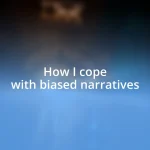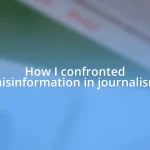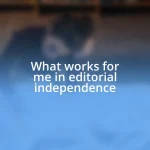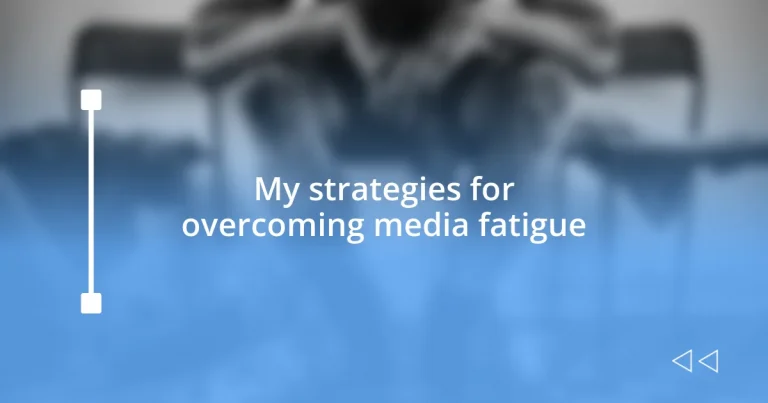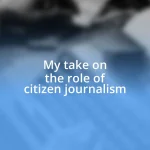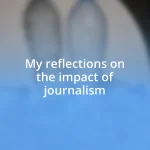Key takeaways:
- Recognizing personal media triggers and setting clear boundaries can significantly reduce media fatigue and improve emotional well-being.
- Prioritizing high-quality media consumption and engaging in mindful practices enhances mental clarity and promotes a positive outlook.
- Establishing a sustainable media routine allows for intentional engagement with content, fostering a healthier relationship with digital media.
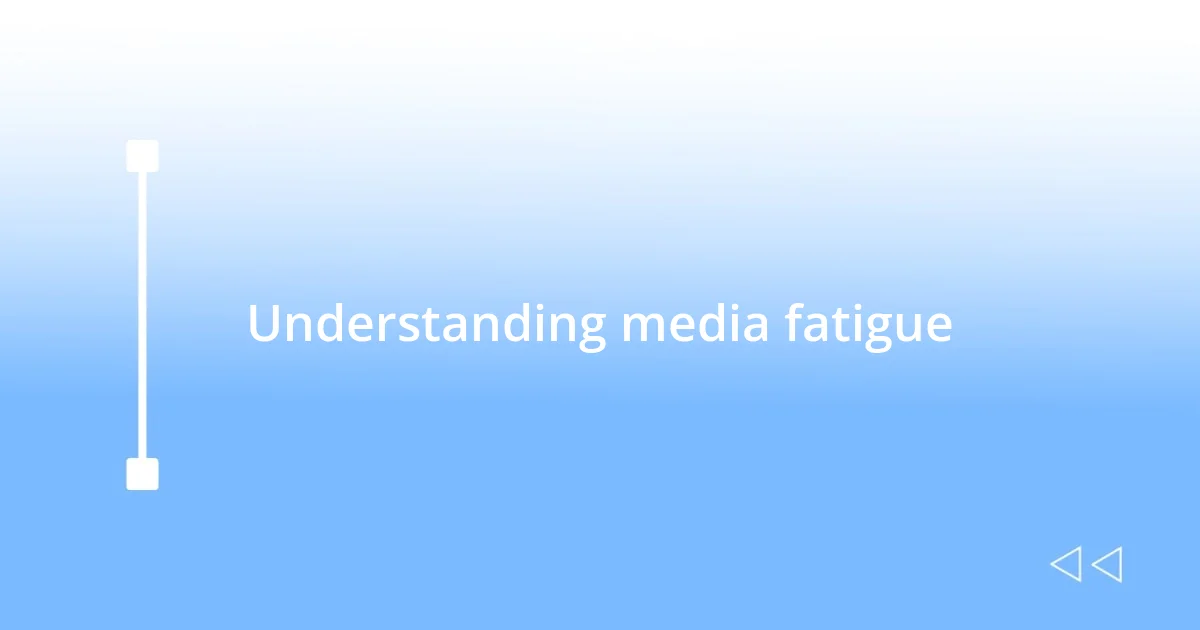
Understanding media fatigue
Media fatigue can feel overwhelming, like trying to drink from a firehose. I remember days when my phone buzzed constantly with updates, leaving me emotionally drained. It’s astonishing how easily we get caught in this whirlwind, isn’t it?
Many of us experience a paradox: amidst the abundance of information, we often crave more connection and meaning. There were moments during the pandemic when I felt lost in a sea of news, navigating fear and uncertainty. Have you ever wondered how this constant influx can actually deepen our feelings of isolation rather than foster community?
Moreover, the way media consumption impacts our mental well-being cannot be overstated. I often found myself scrolling late into the night, only to wake up feeling more anxious than informed. It’s crucial to examine how our relationship with media shapes not just our moods, but also our worldview. Isn’t it interesting to think about the balance we need to strike?
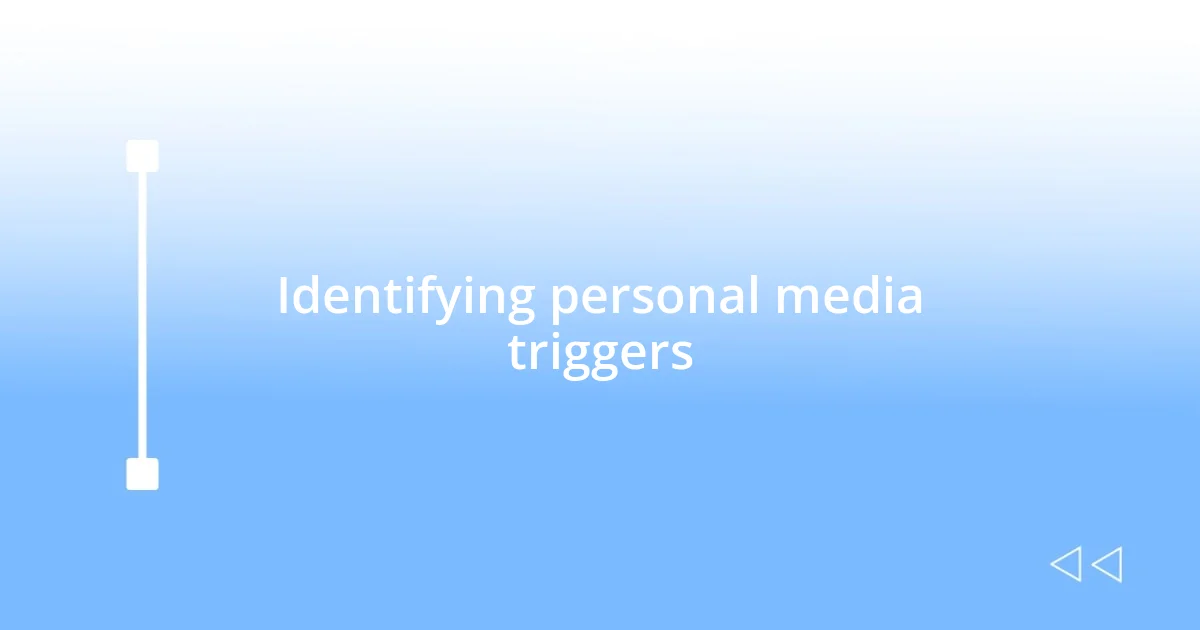
Identifying personal media triggers
Recognizing what triggers your media consumption can be quite eye-opening. For me, certain times of the day—like early mornings or late afternoons—serve as mine. I’ve noticed that when I start my day by checking social media, it often sets a hectic tone, making me feel rushed and anxious. Identifying these patterns in my routine has helped me make conscious choices about when and how I engage with media.
To further pinpoint your personal triggers, consider the following aspects:
- Time of Day: Are there specific times when you feel the urge to check news or social media?
- Emotional State: Do you reach for your device more when you’re bored, lonely, or stressed?
- Environment: Are there particular settings, like being at home or in a café, that prompt you to engage with media?
- Content Type: Do you feel more drawn to certain platforms or types of information, like videos or articles, that may elevate your anxiety?
By reflecting on these elements, you can gain valuable insights into how to manage your media intake more effectively.
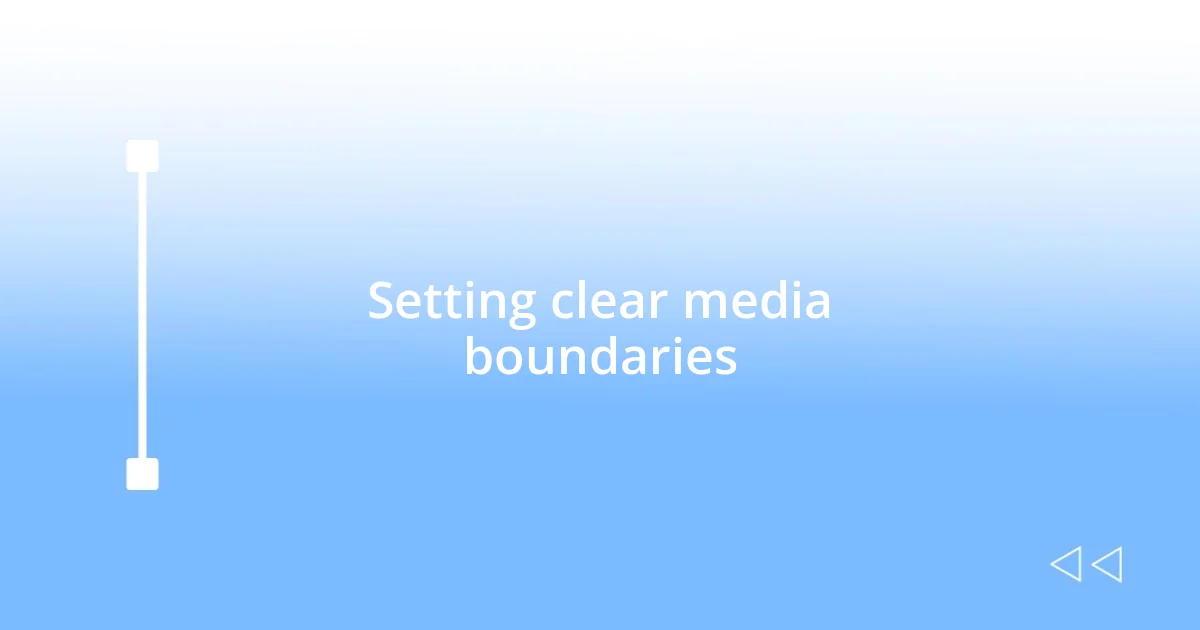
Setting clear media boundaries
Setting clear media boundaries is one of the most powerful strategies I’ve employed to combat media fatigue. I vividly remember a weekend when I turned off all notifications for 48 hours and focused solely on offline activities with my family. It was a freeing experience, allowing me to reconnect with myself and the people around me without distractions. Don’t you think it’s refreshing to experience life without the constant interruption of digital alerts?
Creating boundaries doesn’t just involve turning off notifications; it also means defining specific times for media use. One method that worked wonders for me is allocating “media-free zones” in my home. For example, I decided that dinner time is solely for family conversations, with all devices left in another room. This simple practice transformed our dinner rituals into moments of genuine connection. How do you think setting specific times for media could enhance your relationships?
Lastly, I’ve learned that it’s essential to curate the media I consume carefully. I’ve started following only those sources that uplift or educate me, rather than overwhelm me. For instance, I now enjoy listening to curated podcasts that foster personal growth instead of mindless scrolling through endless feeds. Honestly, narrowing my focus has significantly improved my mental clarity and well-being. Have you considered filtering the content you engage with to create a more positive media environment for yourself?
| Boundary Type | How It Helps |
|---|---|
| Turn off Notifications | Reduces interruptions and allows focus on present moments |
| Set Media-Free Zones | Encourages meaningful interactions and connections |
| Curate Content | Enhances mental clarity and fosters a positive outlook |
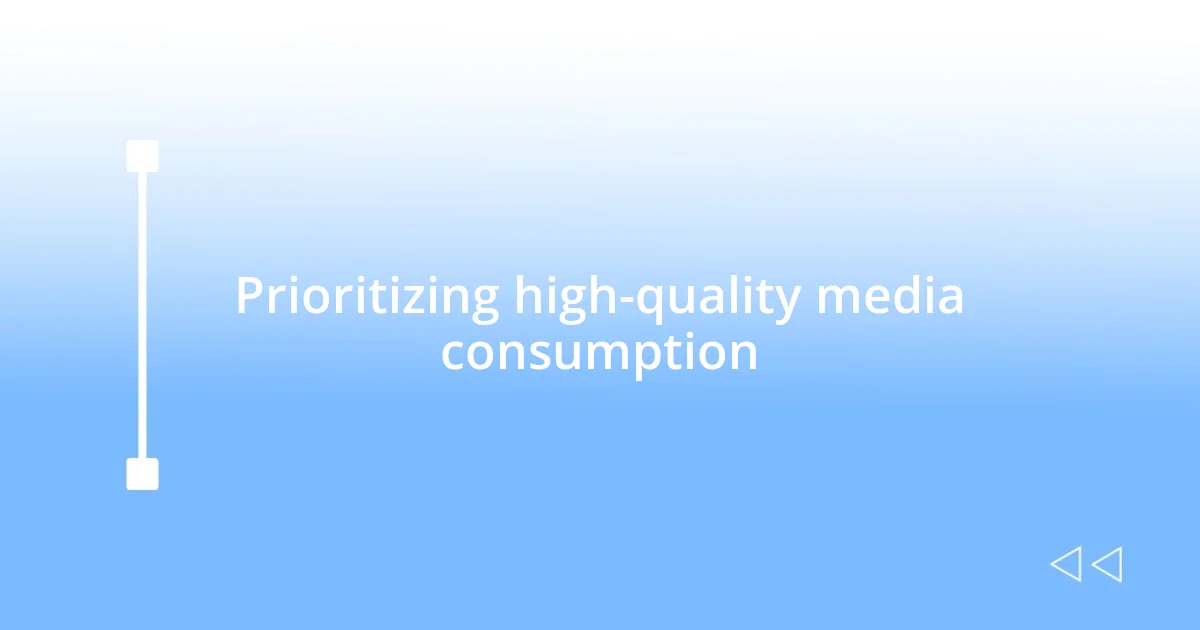
Prioritizing high-quality media consumption
Prioritizing high-quality media consumption is essential in my journey to combat media fatigue. I remember a time when I decided to drop several social media platforms. The result? My mind felt clearer and my emotional state improved. It isn’t just about reducing quantity; it’s about enhancing quality. What if we consciously chose to engage with content that enriches our lives instead of depleting our energy?
When I began selecting media that aligns with my interests and values, I felt a sense of control returning. For instance, I started dedicating time to educational documentaries and books instead of scrolling through the latest viral trends. Have you experienced the difference this shift can make? By focusing on content that challenges my thinking or inspires me, I’ve found that my overall outlook brightens significantly.
Moreover, I often curate my playlists for music and podcasts meticulously. I like to set aside moments to enjoy tunes that uplift my spirit or podcasts that spark my curiosity. This practice not only enhances my daily life but also acts as a subtle reminder that the media I consume can be a source of joy and motivation. Isn’t it powerful to think that with a simple adjustment in our consumption habits, we can cultivate a more positive mental space?
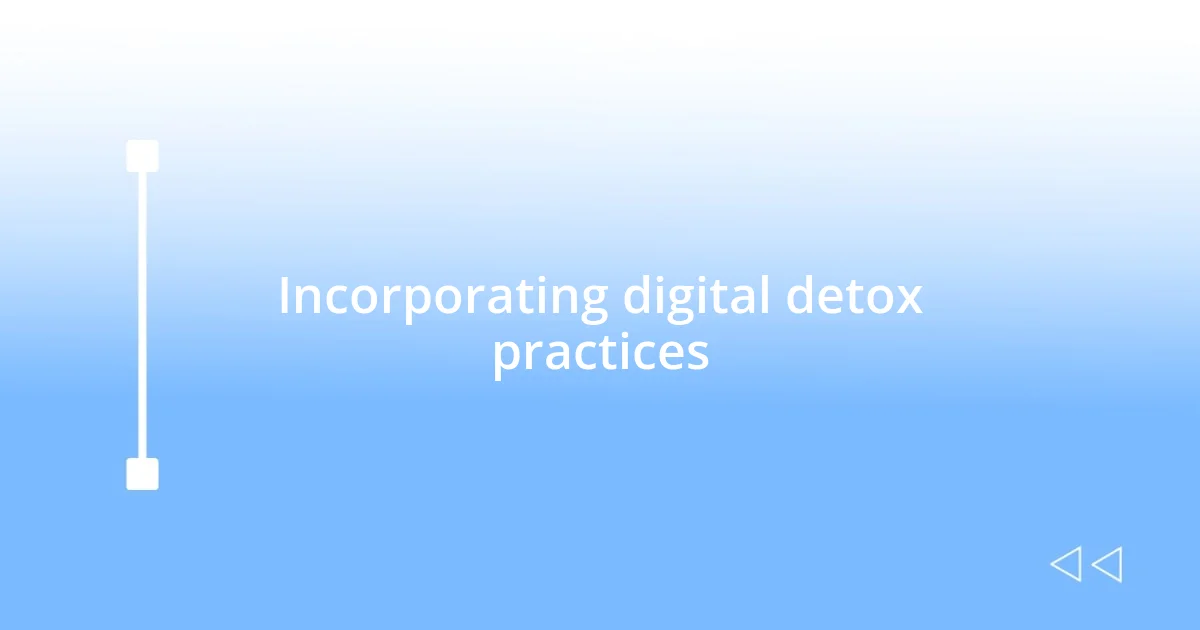
Incorporating digital detox practices
Incorporating digital detox practices has become a cornerstone of my routine. I remember one Sunday, I decided to declare a “no-screen day.” It felt almost revolutionary not to reach for my phone or laptop. I spent the day hiking and immersing myself in nature, which truly rejuvenated my soul. Have you ever tried unplugging for a full day? If not, why not give it a shot?
One strategy that has worked effectively for me is scheduling regular tech-free intervals throughout the week. For instance, every evening after dinner, I take an hour to indulge in a good book. This simple action not only helps me disconnect from devices but also cultivates my love for reading. Reflecting on those moments, I can’t help but wonder how much more enriching our lives could be if we set aside time to engage in activities that nourish our minds.
Additionally, I’ve found that engaging in mindful breathing or meditation really compliments my digital detox efforts. When I wake up, I spend just five minutes focusing on my breath, and it honestly sets a peaceful tone for my day. I invite you to consider what small ritual you might incorporate into your routine to foster a sense of calm amidst the media noise. It’s incredible how even a few moments of true stillness can restore clarity and purpose, don’t you think?
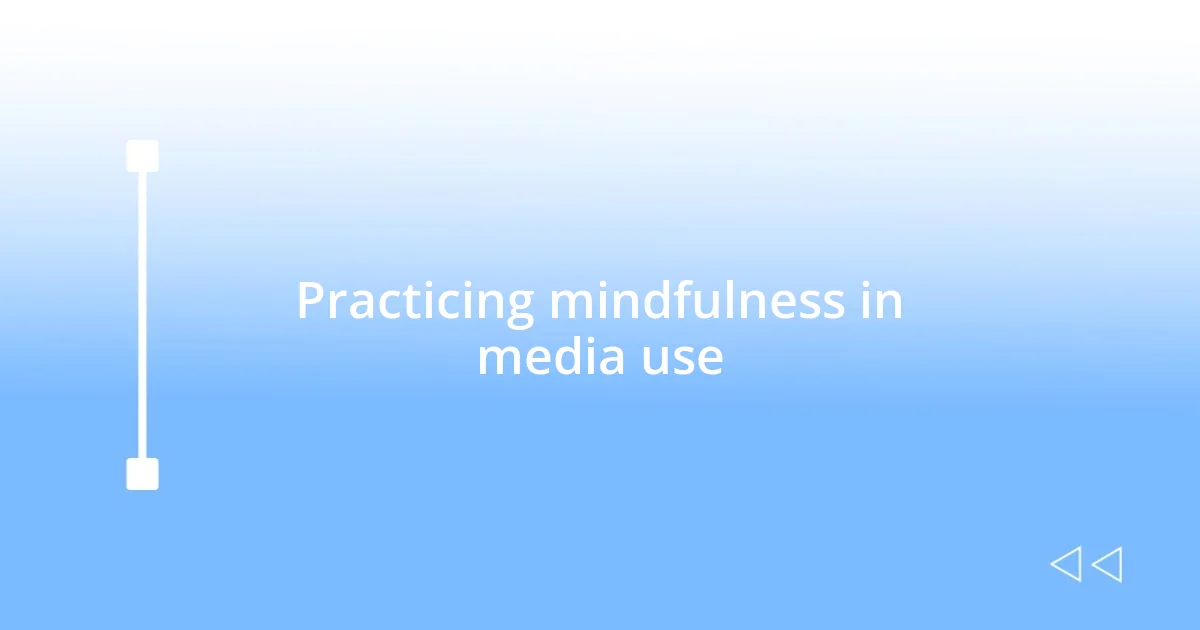
Practicing mindfulness in media use
Practicing mindfulness in media use has profoundly transformed my relationship with digital content. I recall a moment when I attended a workshop on mindful consumption. It was eye-opening to realize how often I mindlessly scrolled through my feeds, absorbing content that didn’t serve me. Since then, I’ve made a conscious effort to pause and evaluate what I engage with. By asking myself, “Does this bring me joy or clarity?” I’ve noticed a marked difference in how I feel afterward. Have you ever taken a step back to consider how your media choices impact your mood?
I’ve also started incorporating short, intentional media breaks during my day. For instance, when I feel overwhelmed, I’ll take just five minutes to close my eyes and focus on my breath before diving back into my screen. This simple practice grounds me and clears my mind, allowing me to return to my tasks with fresh energy. Think about how often we overlook the power of a brief pause. Doesn’t it make you wonder how something so straightforward could yield such significant benefits?
Additionally, I’ve begun journaling my media consumption habits. Tracking what I watch and read, and noting how I feel afterward, has been enlightening. There were days I watched the news and felt anxious for hours. By being mindful, I’ve learned to limit exposure to the negative and switch to uplifting or educational content. Have you documented how your media impacts your emotions? It’s fascinating how awareness can lead us to make small changes that foster a healthier media diet.
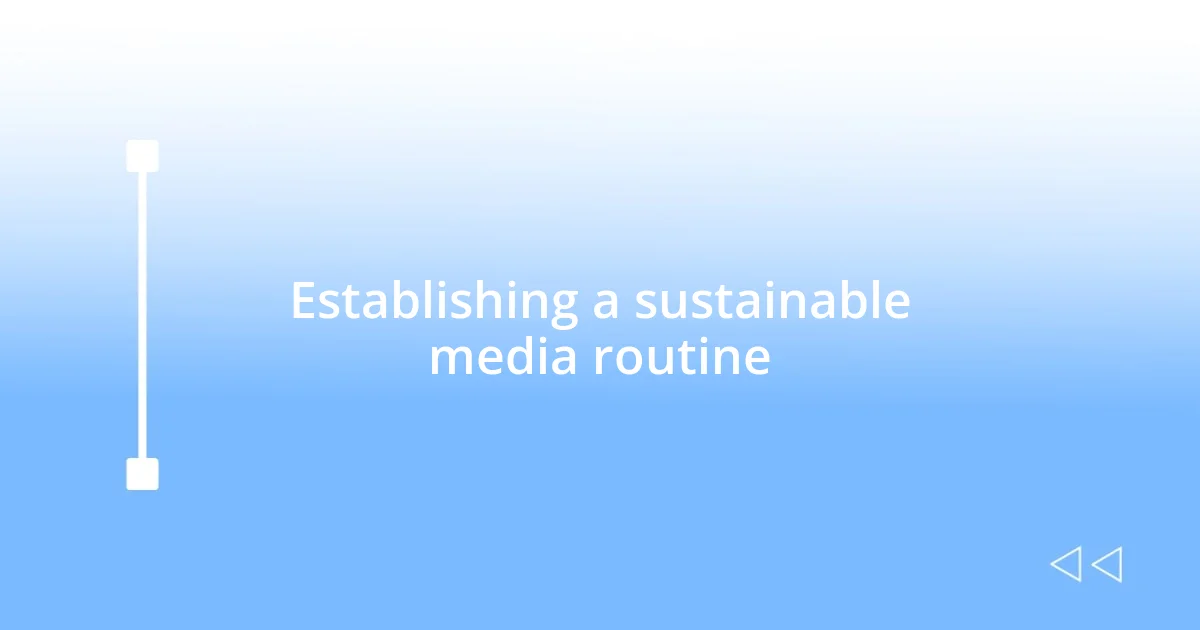
Establishing a sustainable media routine
One effective way I’ve established a sustainable media routine is by creating a personalized schedule for my media consumption. For instance, I’ve allocated specific times in the day, like mid-morning or early afternoon, to catch up on the news or browse social media. I remember the liberation I felt once I stopped mindlessly checking my phone every few minutes. Have you ever thought about how setting boundaries could free up valuable time for other pursuits?
On weekends, I dedicate Sunday mornings to catching up on articles and podcasts that inspire me. This ritual allows me to engage with media that feeds my curiosity rather than depletes my energy. The difference is noticeable; I approach each piece of content with excitement and intention. What could it look like for you to carve out time for the media that truly resonates with you?
Moreover, I’ve learned to embrace flexibility in my routine. Some days are busier than others, and that’s okay! If I miss my scheduled media time, I don’t beat myself up. Instead, I adapt, allowing myself to catch up later or even opt for a creative activity instead. It’s all about finding balance and not letting the digital world control my day. How adaptable is your media routine? Striking that balance can make all the difference in preventing burnout and fostering a positive media experience.


